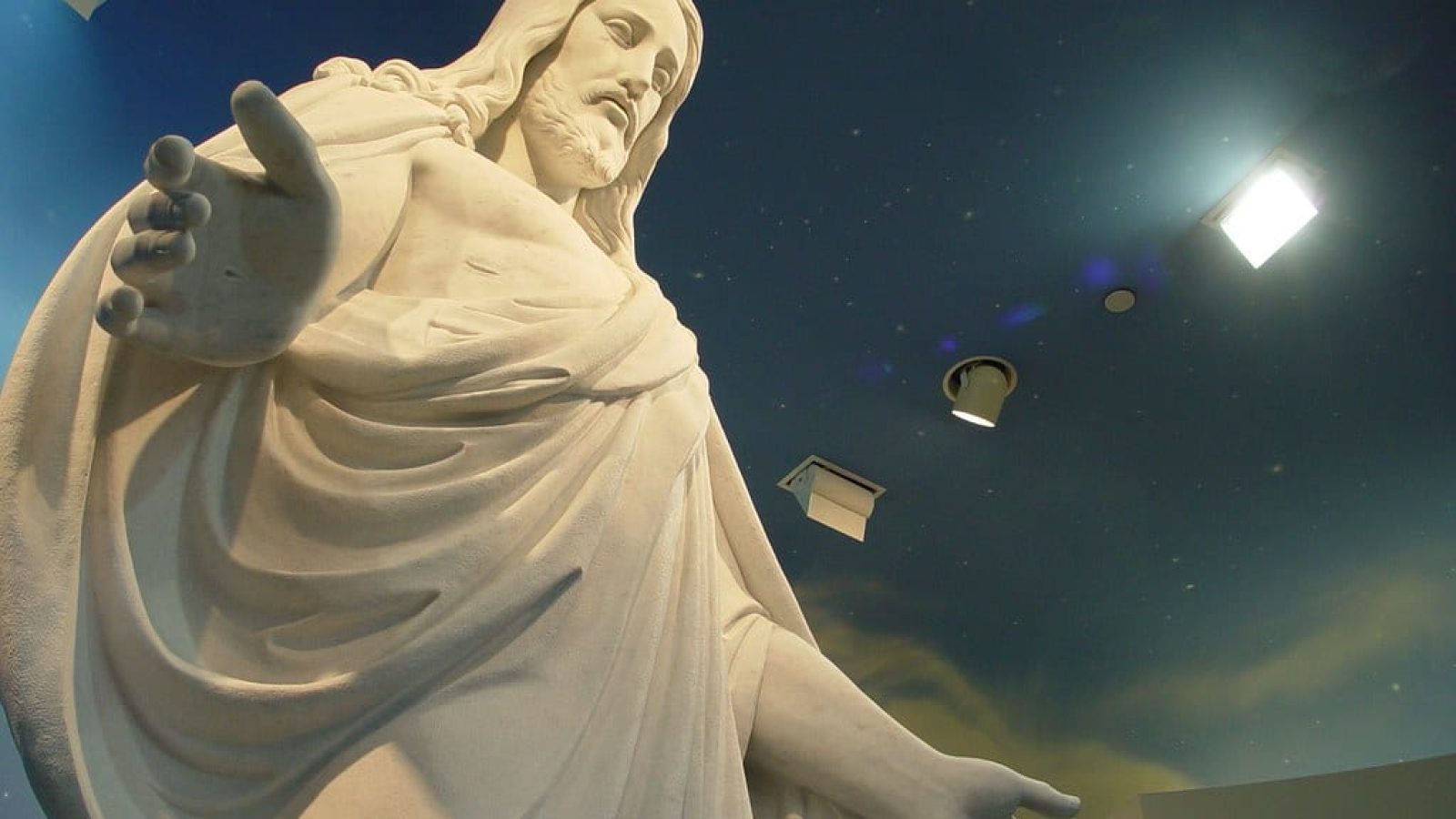I saw #Satanic was trending today on Twitter.
So that’s interesting.
It is, after all, Christmas day.
It appears to be trending due to the people who say Jesus wasn’t really born on December 25…
The day originates out of Saturn Worship…
And the day is, well, #Satanic.
But that’s not my take.
Most of that is true, but I’m not here to bring you that message.
I say celebrate on December 25th if you want, and make it holy.
Reclaim it.
I’m ok with that.
I’m not one of these people who is going to tell you to swim upstream and ignore the whole rest of the world.
But…it is very interesting…
Do you know what day it is most commonly believed by scholars that Jesus was actually born?
September 11.
Yes, that’s right.
And suddenly, more puzzle pieces now fit together, don’t they?
You see, they had to take a day that was Holy and try to desecrate it with what happened on 9/11/01.
They chose that day VERY intentionally.
Because it was one of the two most important dates of the calendar (Jesus’ birth and Jesus’ death — Christmas and Easter, the true versions).
In fact, not only do scholars believe Jesus was born on September 11, they believe it was September 11 in 3 B.C., which also happened to be The Day of Trumpets; the Feast of Trumpets; and Rosh Hashanah: Head of the Year, or Feast of the New Year in 3 BC. All names for the same day!
The Feast days move around the calendar each month, much like Easter does.
It’s on the same day of the lunar calendar, but not the same day as our calendar.
So it shifts a bit, but is always in roughly the same general period.
God seems to love doing big events on Biblical Feast Days so it would make much more sense for Jesus to be born on the Feast of Trumpets / Rosh Hashanah rather than December 25.
SPOILER ALERT: whenever he comes back (and he is coming back), expect that to be on a Feast Day.
No one knows the day or the hour, but I’m pretty sure it will be on one of 4 days each year…
Whether that is this year, in 10 years, or in 1,000 years no one knows.
But it sure does feel close, doesn’t it?
Back to His birthday…
Here’s more, from TruthInScripture:
Evidence for the Birthdate of Jesus Being on the Feast of Trumpets
In Revelation 12:1-6 the Apostle John is presenting something of great significance in a symbolic way. The date of September 11, 3 BC was Tishri 1 on the Jewish calendar in 3 BC. Tishri 1 is, of course, the 1st day of the first Jewish month. This date is also called Yom Teruah: The Day of Trumpets; the Feast of Trumpets; and Rosh Hashanah: Head of the Year, or Feast of the New Year.
From the proper astronomical interpretation of Revelation 12:1-6 (see previous Post: Jesus’ Birth – Astrological/Zodiacal References in Scripture), the only day in 3 BC which meets the astronomical confluences discussed is September 11, 3 BC, during the period of sunset to moonset, 6:18 pm to 7:39 pm. The close proximity of the positions of the sun and the moon as described in Revelation indicate a new moon time frame, which is exactly the situation which exists on the first day of a Jewish lunar month, as on Tishri 1, the Feast of Trumpets. Jesus must have been born on the Feast of Trumpets, as no other day of the year in 3 BC could astronomically meet the specific requirements detailed in Revelation.
We can then also conclude that Jesus’ birth was not on the Feast of Tabernacles or on Passover, as others have proposed. Both the Feast of Tabernacles and Passover occur in the middle of lunar months; therefore, there can be no new moon, as required by Revelation 12:1-6.
Significance of Tishri 1 (Feast of Trumpets; Rosh Hashanah)
There is a great deal of significance associated with the fact that Jesus was born on Tishri 1. This significance was evident to the Apostle John when he wrote Chapter 12 of the book of Revelation.
The early Jewish Christians considered Jesus to be the Messiah (Christ). And because He was born on the Feast of Trumpets, they also considered Him to be the King of the Universe. The theological understanding of the Jews within their synagogue services for the Feast of Trumpets was that God rules over all and that He is the King of kings. Zechariah 14:16 was commonly quoted in this regard: “The king, the Lord of hosts.” Some have argued that the “enthronement Psalms” (Psalms 47, 93, 96-99), in which Yahweh reigns, were a part of the liturgy of the ancient synagogues on this date. This was the very date on which Jesus was born.
The Feast of Trumpets (Rosh Hashanah) is the start of the Jewish civil year. Before God told Moses that the month of the Exodus (Nisan) was to become the start of the religious year, Tishri 1 was the start of all years, from Creation to the Exodus from Egypt. There is an impressive assortment of biblical and prophetic scenes which align with this date. The Day of Trumpets was the day that commemorated the creation of the world, the first day of Genesis 1:1-5. We’re talking the birthday of the world! It is very fitting that the Creator of the world (John 1:1-3, 14) would come into the world on this date!
In Genesis we also find a reference to Tishri 1 in the account of Noah and the ark:
“By the first day of the first month of Noah’s six hundred and first year, the water had dried up from the earth. Noah then removed the covering from the ark and saw that the surface of the ground was dry” (Genesis 8:13 NIV).
This was not only the birthday of Noah but, in a sense, the birthday of a new world, as well. All on Tishri 1!
Tishri 1 was also the day that many of the ancient kings and rulers of Judah regarded as their inauguration date. This was certainly the case with Solomon, Jeremiah, and Ezra.
One of the key themes of the Day of Trumpets is kingship, and The Day of Trumpets was used in counting the years of a king’s rule. It only seems fitting that Jesus came into the world on this auspicious date. It is also possible that the patriarch Joseph of Egypt, who is a type of Christ in the Old Testament, rose to “kingship” on this new moon day, which began the month of Tishri. He had been in captivity in a dungeon for “two full years” (Genesis 41:1). The implication is that Joseph rose to “kingship” on a New Year’s Day. Psalm 81 (vv. 3, 5) is a New Year’s Psalm referencing Joseph’s royal enthronement (Genesis 41:40); the kingdoms of the world became Joseph’s on the day intended for coronations – the day which later became the Feast of Trumpets. Pharaoh still retained position over Joseph, just as God the Father is Lord over Jesus, even though Jesus was prophesied to rule the kingdoms of this world. Joseph therefore prefigured Jesus in many aspects of his life.
And also from one of the absolute best Biblical scholars alive today, at least in my opinion, Dr. Michael Heiser:
Many readers will know that I believe the actual birthdate of Jesus was Sept 11, 3 BC. This isn’t based on any original research of my own (here’s a short YouTube video of me discussing the date). Rather, it is based on the work of E. L. Martin’s The Star that Astonished the World (which can be read for free). Most academics are unaware of Martin’s research because he wasn’t a member of the biblical studies guild. Others reject it out of hand because of Martin’s involvement with the old Worldwide Church of God. The quality of one’s research, however, doesn’t depend on having a PhD in biblical studies or whether one is doctrinally correct in all areas. I don’t buy Martin’s views on other things, but I find his work on the birth of the messiah persuasive (and it has a long history of endorsement in planetariums).
As noted, most academics have no inkling about Martin’s work or its basis. In briefest terms, Martin considers Rev 12:1-7 to describe the actual celestial events of the birth of the messiah (which birth is part of the context of Rev 12:1-7). Most New Testament scholars don’t consider Rev 12 as astral prophecy. The major voice in that regard is Bruce Malina, a well-known New Testament scholar. Unfortunately, Malina dramatically overstates his case in his book, On the Genre and Message of the Book of Revelation. Malina argues that (basically) the entirety of the book of Revelation is astral prophecy. Scholars like G. K. Beale and David deSilva have rightly pointed out Malina’s near total neglect of the Old Testament context of John’s Revelation. Malina’s work deserves such criticism. But it’s misguided to think that we have to choose between seeing astral prophecy everywhere in Revelation to the neglect of how John uses the Old Testament, and seeing it nowhere. I don’t buy that either-or fallacy.
Martin’s thesis has, of course, been critiqued in some detail. There are problems, but none of them are insurmountable and can be rebutted with good evidence. This reality, along with the comprehensive explanatory power Martin’s work, as well as the date’s remarkable synchronicity with Jewish messianic symbolism and calendar, make Martin’s work persuasive to me. Most of the criticisms of Martin’s work revolve around the fact that it requires a date of 1 BC for the death of Herod the Great, something that flies in the face of the (current) consensus of 4 BC for that event. Critics of a 1 BC death for Herod that I have read seem oblivious to the past and recent work in defense of that date — at least I have found references to that research lacking in their criticisms. A date of 1 BC for Herod’s death is not only possible, but more accurately reflects the data now available. The two best sources for defending Herod’s death in 1 BC — which, again, seem utterly neglected in criticisms of Martin’s work — are:
1) The difficult to find article by Ormond Edwards, “Herodian Chronology,” Palestine Exploration Quarterly 114 (1982): 29-42. Edwards’s article is a study of Herodian coinage and its implications for dating Herod’s reign, including his death. Edwards’ research shows that the death of Herod the Great was Tishri 1, 3 BC (Martin’s Sept 11) by the civil new year’s calendar, or Nisan 1, 2 BC using the ecclesiastical calendar. Edwards writes in his conclusion:
“It is concluded that Josephus in Jewish War was mistaken in his handling of the calendars of the Herodian period. He dated all the Herods’ reigns from the spring new year, whereas the earlier Herods (excluding Agrippa II) dated their coins from the autumn civil new year’s day preceding accession. The error comes to light only when the data in Josephus is compared with the coin dates.”
2) The more recent article by an expert in biblical chronology, Andrew Steinmann, “When Did Herod the Great Reign?” Novum Testamentum 51 (2009) 1-29. The abstract of this article reads:For about 100 years there has been a consensus among scholars that Herod the Great reigned from 37 to 4 BCE. However, there have been several challenges to this consensus over the past four decades, the most notable being the objection raised by W. E. Filmer. This paper argues that Herod most likely reigned from late 39 BCE to early 1 BCE, and that this reconstruction of his reign can account for all of the surviving historical references to the events of Herod’s reign more logically than the current consensus can. Moreover, the reconstruction of Herod’s reign proposed in this paper accounts for all of the datable evidence relating to Herod’s reign, whereas the current consensus is unable to explain some of the evidence that it dismisses as ancient errors or that it simply ignores.
The above articles are not in the public domain, so I cannot post them. However, I can get copies to interested parties if you subscribe to my email list and the newsletter. This option is only for a limited time. It will start with the next issue (#5) but not continue indefinitely.There are other issues in Martin’s work that need scrutiny. I’m actually engaged in doing that at present. Having just handed off the manuscript of a new book on 1 Enoch (focused on the importance of the Watchers’ transgression for New Testament theology) that will launch Feb-March 2017, I’m now turning my attention to a partially-written manuscript on astral prophecy. That book will aim to explain what astral prophecy is and isn’t, and expose abuses of it in Christian prophecy talk.
By way of illustrating the abuses, one of the reasons Martin’s work has drawn criticism is because some Christians think that the celestial imagery of Rev 12:1-7 somehow (a) affirms biblical prophecy, or (b) plays a role in future prophecy. The first is simply not true. There was no Old Testament prophecy about the specific astronomical events in Rev 12 signaling the birth of the messiah. The book of Revelation was the last book of the New Testament. It was written well after the birth of Jesus. Revelation 12:1-7 wasn’t a prediction about celestial events and the messiah. Rather, John is giving us the celestial circumstances handed down to him by unnamed witnesses and (effectively) establishing the birth with significant celestial signs. This isn’t a contrivance on his part because the Sept 11 3 BC date must (and does) work with the rest of the chronology of Jesus’ life produced by the New Testament and other sources. In regard to future prophecy, there is no verse in the Bible that tells us: (a) that the signs of Jesus’ birth will be mirrored at his second coming, or (b) that the signs of Rev 12:1-7 are the meaning of “the sign of the son of man” mentioned in relation to the second coming (Matt 24:30). Anyone who tells you they can predict the time of the second coming based on a repetition of the celestial events of Rev 12:1-7 should be ignored.
Another abuse comes from folks out there who are using the celestial signs of Rev 12 to predict the rapture and the tribulation are going to happen on Sept 23, 2017. I’m not a prophet, nor the son of a prophet, but I’m going to predict something: This won’t happen. This is a false prophecy. I’m not going to be chummy toward people who abuse Scripture after the fact, like saying certain passages predicted the fall of the twin towers or an American financial collapse, or [fill in the blank with a modern event impacting America]. Sorry, but America isn’t the focus of biblical prophecy. I don’t care what code language they think they’ve figured out (or had channeled to them by special revelation). Ignore these people. Their exegesis is awful (if I were Ezekiel I might use scatological language now, but like I said, I’m not a prophet).
I have many reasons for criticizing modern “prophetic” use of Rev 12:1-7, but I’ll save that for the book. For now I’ll just say that much of what passes for “application” of Rev 12:1-7 misses something very important: the other celestial signs associated with the birth of Jesus that were present on Sept 11, 3 BC that are not mentioned in Rev 12:1-7 (i.e., there’s a lot more going on in the sky than the items John mentions). Our modern “prophets” don’t seem to be aware of that. But even if they were, see the above — there is nothing in the Bible that says any of this should matter for the second coming.
The bottom line is that if I, or anyone else, tells you they know when the Lord is returning, ignore it. That said, I’m not dumb enough or vain enough (or in the habit of ignoring Matt 24:36) to do that. I’m not going to portray myself as a prophet to dupe you into buying something from me, thinking you’re getting secret information dispensed to me from on high. I just do biblical scholarship and give readers the academic breadcrumb trail. You know the drill if you’ve followed my work for any time. Sure, I’m interested in astral prophecy, but I’m just a biblical scholar. I’m blessed to have an astronomer who has an eye for all this material to provide fodder for consideration and check my own work. Fans of my novel, The Portent, know that person by the name Mantello, as that novel, the sequel to The Facade, weaves astral prophecy into the storyline (which will continue in the third novel). Mantello is not the real name of the astronomer who works with me, nor is he a mute Pakistani teenager, but he is indeed real. I’m meeting with him, Lord willing, in November to talk about the book manuscript. He’s an invaluable resource. Please pray that my time with Mantello is productive.
Here’s one more, from JewishRoots:
Many scholars believe Jesus was born during the Feast of Tabernacles. Matthew Henry states:
“It is supposed by many that our blessed Saviour was born much about the time of this holiday; then He left his mansions of light above to tabernacle among us (John 1:14), and he dwelt in booths. And the worship of God under the New Testament is prophesied of under the notion of keeping the Feast of Tabernacles (Zec.14: 16).”
For the gospel of Christ teaches us to dwell in tabernacles, to sit loose to this world, as those that have here no continuing city, but by faith, and hope and holy contempt of present things, to go out to Christ without the camp (Heb. 13:13, 14).
It teaches us to rejoice before the Lord our God. Those are the circumcision, Israelites indeed, that always rejoice in Christ Jesus (Phil. 3:3). And the more we are taken off from this world the less liable we are to the interruption of our joys.
The Bible does not specifically say the date of Jesus’ birth. We know it was not during the winter months because the sheep were in the pasture (Luke 2:8). A study of the time of the conception of John the Baptist reveals he was conceived about Sivan 30, the eleventh week.
When Zechariah was ministering in the temple, he received an announcement from God of a coming son. The eighth course of Abia, when Zechariah was ministering, was the week of Sivan 12 to 18 (Killian n.d.). Adding forty weeks for a normal pregnancy reveals that John the Baptist was born on or about Passover (Nisan 14). We know six months after John’s conception, Mary conceived Jesus (Luke 1:26-33). Therefore, Jesus would have been conceived six months later in the month of Kislev. Kislev 25 is Hanukkah. Was the “light of the world” conceived on the festival of lights?
Starting at Hanukkah, which begins on Kislev 25 and continues for eight days, and counting through the nine months of Mary’s pregnancy, one arrives at the approximate time of the birth of Jesus at the Festival of Tabernacles (the early fall of the year).
During the Feast of Tabernacles, God required all male Jews to come to Jerusalem. The many pilgrims coming to Jerusalem for the festivals would spill over to the surrounding towns (Bethlehem is about five miles from Jerusalem). Joseph and Mary were unable to find a room at the inn because of the influx of so many pilgrims.
They may have been given shelter in a Sukkah, which is built during a seven-day period each year accompanying the celebration of the Feast of Tabernacles. Due to the difficulties during travel, it was common for the officials to declare tax time during a temple feast (Luke 2:1).
We know our Messiah was made manifest into a temporary body when He came to earth. Is it possible He also was put into a temporary dwelling? The fields would have been dotted with Sukkoths during this harvest time to temporary shelter animals. The Hebrew word “stable” is called a Sukkoth (Gen. 33:17).
“And she brought forth her firstborn son, and wrapped him in swaddling clothes, and laid him in a manger; because there was no room for them in the inn (Luke 2:7).”
Joseph and Mary took the child and flew to Egypt and remained there until they were told by God that Herod was dead. Joseph and Mary brought the baby Jesus into Jerusalem forty days from His birth for Mary’s purification and the child’s dedication (according to Torah this had to be done within forty days of the birth of a male child–not doing so is considered a sin). This indicates that Herod died within the same forty days, because as long as Herod was alive, they could not appear at the Temple. (According to Josephus’ calculations, Herod’s death occurred during the Autumn in the fourth year before the Common Era 4 b.c.e.).
Now I want to wrap this up back where we started…
With the reason #Satanic was trending on Twitter today.
And I want to use this opportunity to expose these evil people and their evil symbols.
Because Symbolism will indeed be their downfall.
Check this out:
https://twitter.com/Natasha38585763/status/1604223846760022019
One of the worst offenders?
THIS guy 👇
https://twitter.com/doubleDutchquak/status/1605551810357465088
Once you learn the symbols, you start to see them everywhere.
You see how Big Business just LOVES using these, thinking it will give them more power:
https://twitter.com/billgray52/status/1604916338245652480
So disgusted by you Jeep!
One of their biggest and most used symbols?
Especially in America?
The Bull.
Sure, as Freud said, “sometimes a bull….is just a bull.”
But often it’s a very intentional call out to BAAL….straight out of the Old Testament.
Take a look:
https://twitter.com/philotheos33/status/1606777235788152834
Ever been to Wall St.?
Then you’ve seen this.
Now realize this has nothing to do with trading stocks…
It’s a very intentional “Golden Calf”.
Literally:
Just thought of the Wall Street bull in New York's financial district… [Baal] pic.twitter.com/HtdojTOJS9
— Callie Allie ✝️🇺🇲 (@csimons3) October 3, 2022
Wall Street was created by a bunch of pharisees, saducees and heiresees – zionist look at that Golden Bull = Baal Worship same thing they did when they left Egypt to Israel made a golden calf and worshipped it
— 𝚇𝚊𝚗𝚘𝚗 𝙰𝚍𝚘𝚗𝚊𝚒 (@Xanon24) October 29, 2022
Think Exodus and Moses are only fiction?
It’s being replayed before your very eyes in our world:
Golden Calf -Baal worshipped in Egypt. Cleopatra's modified version of the golden calf, Wall street bull, Baphomet. The images are too similar for them to be a coincidence. pic.twitter.com/AFQiXxdBku
— N. Swan 🌞🦢🇺🇲🇺🇲🇺🇲 (@Na0m111) November 20, 2020
The ancient world worshipped a “god” in the form of a bull who promised power & prosperity if they would offer up their children in sacrifice.
The Egyptians called him Apis.
The Canaanites called him Baal.
Today we call him Wall Street & our children owe him $305 trillion. pic.twitter.com/mgHTGol4yp— Christene B (@ChristeneB7) November 24, 2022
Think all the “pagan god worship” from the Old Testament died out?
Hardly.
It’s alive and stronger than ever:
The ancient world worshipped a “god” in the form of a bull who promised power & prosperity if they would offer up their children in sacrifice.
The Egyptians called him Apis.
The Canaanites called him Baal.
Today we call him Wall Street & our offspring owe him $305 trillion. pic.twitter.com/y65X44J8jh— ŁØǤΔŇ (@FullStackLogan) November 29, 2022
Here’s even more…
UPDATE: Symbolism Will Be Their Downfall
Ever wonder why there’s a pyramid with the top cut off on every U.S. dollar bill?
Or why famous people constantly cover one eye?
Or why they love to pose with their right hand inside their jacket?
If you don’t know what I’m talking about…let me give you an intro right here.
Four examples.
Really simple.
You’re going to see the same signs over and over and over in these 4 pictures.
The signs include:
- The “OK” symbol, which also just happens to create a 6-6-6
- Covering the mouth (as in, secret society)
- Shhh finger over the mouth (same)
- Two fingers or “V” (symbol for Satan)
- Tongue out (an homage to the Snake from Genesis)
- Covering one eye or closing one eye (a very weird gesture repeated incessantly by the Elites — a call out to the “All Seeing Eye” of Horus)
- One hand inside the jacket
Many times you will see two or more symbols combined at once.
Take a look:




But we’re just getting warmed up…
Sure, some of it could be coincidence, but after a while you have to wise up and realize perhaps they don’t all just love winking and sticking one hand inside their jacket…
Perhaps it’s intentional?
Perhaps it’s sending a message?
Because who does that?
WHY would you do that?
Symbolism will be their downfall.
And yes, that’s exactly what it was:
If you need more than this to wake you up to what's going on, your brain dead, not asleep.
That is the hand sign of the Illuminati. pic.twitter.com/HaPNaUbVIM— 𝒲𝒾𝓁𝓁𝒾𝒶𝓂 𝒪𝒻 𝑀𝒶𝓇𝓎 🇨🇦 🇺🇸 (@fore_not_four) April 30, 2022
Another angle, still shot:
Very sinister indeed 🤣 pic.twitter.com/DMb7N3wGLs
— Rot van Rotterdam (@RotVanRotterdam) April 30, 2022

Oh, Tulsi….is that you?
She did attend Swaub’s workshop conference 😱 pic.twitter.com/roQvxNPWmH
— Les is More 🔲 (@faulk_les) April 30, 2022
And then we have the Devil Horns….
Oh wait, I forgot, these people are all just big Texas Longhorn fans, right?
https://twitter.com/makerbreiz/status/1520685287185305600
And covering the one eye:
https://twitter.com/BennnetMaria/status/1520507892385861633
And here’s Jacko doing the one eye:

Who poses like that?
I mean, unless….it’s a sign and symbol.
And sadly here is Tom Hanks doing a bunch of “one eye” poses.
Because this is normal?
So sad to see “Hanx” is a part of this garbage:
 And whatever the hell this is:
And whatever the hell this is:
https://twitter.com/makerbreiz/status/1520486218055790593
And how about Disney?
They above all else are STEEPED in these Satanic ritual symbols…
Here’s just a few:
— conspiracybot (@conspiracyb0t) April 25, 2022
We’ve covered this topic many times before, so if you want more check out these articles where we dive deep:
https://wltreport.com/2020/08/26/dnc-and-rnc-logos-exposed-symbolism-will-be-their-downfall/
And this:
https://wltreport.com/2022/05/01/fact-checked-true-proof-zelensky-is-new-world-order/
And this:
https://wltreport.com/2022/02/08/we-investigate-suddenly-the-2012-olympics-opening-ceremony-makes-a-lot-more-sense/
And of course this:
https://wltreport.com/2021/03/25/adrenachrome-black-eye-club-finally-exposed-in-detail/



Join the conversation!
Please share your thoughts about this article below. We value your opinions, and would love to see you add to the discussion!